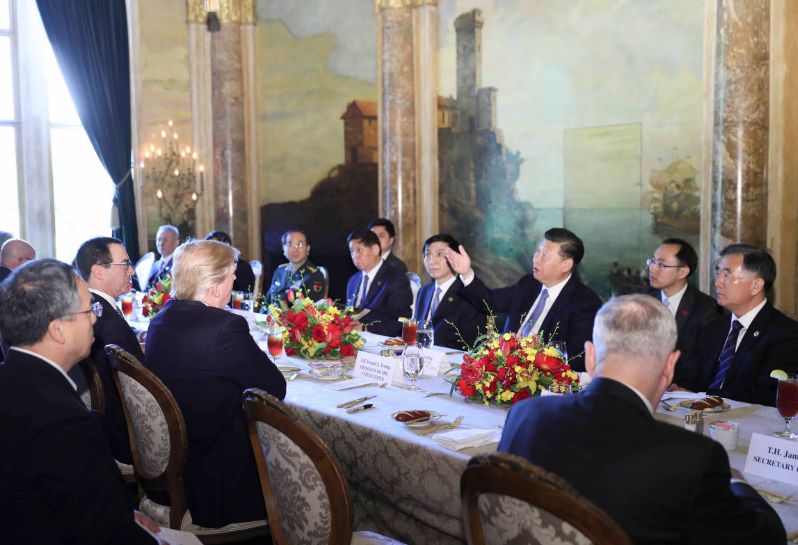
Financial Times writes that as Donald Trump's first 100-day clock runs out on a tumultuous start to his presidency, he and Xi Jinping have set a second one in an effort to avert an all-out trade war between the world's two largest economies. A 100-day plan to address trade imbalances between China and the US was the most important outcome of the two presidents' meeting last week in Mar-a-Lago, Florida. The details of the plan are still being worked out but are likely to include Chinese concessions on everything from agricultural imports to foreign investment in its financial sector, according to Chinese and US officials involved in the negotiations. Speaking to reporters at the conclusion of Mr Trump and Mr Xi's first face-to-face meeting on Friday, US cabinet officials said the goal was to agree on a way to increase US exports to China and to reduce the $347bn trade deficit in goods between the two countries. According to Andrew Nathan, a Sinologist at Columbia University, plenty of low-hanging fruit is on offer. "US negotiators are pushing on a door that is relatively easy to open when they place a priority on improving the trade balance not by limiting Chinese exports to the US, but by increasing US exports to China," he said.
Former Treasury Secretary Summers comments on the Washington Post that Trump and Chinese President Xi Jinping have now completed their first summit. Observers on both sides seem to be relieved. If no diplomatic breakthroughs on major issues were achieved, it is also the case that there were no outward displays of truculence from either side. Neither high hopes nor great fears have been realized...focusing on China's trade deficit with the United States is largely misguided...It is difficult to overestimate the extent to which China is seeking to project soft power around the world by economic means...A truly strategic U.S.-China economic dialogue would revolve around the objectives of global cooperation and the respective roles of the two powers. It is important that such a dialogue start soon, but this move will require the United States to focus less on specific near-term business interests and more on what historians will remember a century from now.
CNN reports that a US aircraft carrier-led strike group is headed toward the Western Pacific Ocean near the Korean Peninsula, a US defense official confirmed to CNN. The move of the Vinson strike group is in response to recent North Korean provocations, the official said. Adm. Harry Harris, the commander of US Pacific Command, directed the USS Carl Vinson strike group to sail north to the Western Pacific after departing Singapore on Saturday, Pacific Command announced...It is not uncommon for aircraft carriers to operate in that area, and the United States regularly deploys military assets, such as aircraft, to the region as a show of force. In fact, the Vinson was in South Korea last month for military exercises...News of the carrier move comes just after a summit meeting between US President Trump and Chinese President Xi Jinping, where North Korea was one of the top items on the agenda. US Secretary of State Rex Tillerson said Trump and Xi agreed on the "urgency of the threat of North Korea's nuclear weapons program" and agreed to work together to resolve the issue "peacefully."
- 2017-04-07 At U.S.-China summit, Trump presses Xi on trade, North Korea; progress cited
- 2017-04-06 Signs point away from Trump labelling China currency manipulator
- 2017-04-05 Trump and China: Ahead of Summit, Both Sides Try to Reset Volatile Relationship
- 2017-04-04 Trump-Xi meeting watched for clues of future relationship
- 2017-04-03 What those papers Trump left on his desk reveal about his trade policy
- 2017-03-30 Climate change: China calls US 'selfish' after Trump seeks to bring back coal
- 2017-03-29 China Poised to Take Lead on Climate After Trump’s Move to Undo Policies
- 2017-03-28 China able to deploy warplanes on artificial islands any time: U.S. think tank
- 2017-03-27 China’s influence on global finance grows as US scales back input
- 2017-03-26 Beijing-backed Carrie Lam chosen as next Hong Kong leader
- Bloomberg Xi Buys Time With Trump as Tensions Loom Over North Korea Threat
- Bloomberg Ford CEO Says Trump-Xi Meeting Helps Strengthen U.S.-China Ties
- Bloomberg Duterte Softens Tone Toward U.S. Before Talks on South China Sea
- Market Watch Wilbur Ross says US wants 'tangible results' with China — and soon
- RT News Syrian crisis buys Washington & Beijing more time to consider North Korea standoff
- Bloomberg China's Moutai Tops Diageo as Most-Valuable Liquor Maker: Chart
- CNBC China anti-graft body investigating chief insurance regulator
- New York Times Tillerson Says Missile Strikes Carry a Message for Others
- Reuters China's HNA offers to buy Singapore's CWT for $1 billion
- USA Today In gun-taboo China, tourism to US firing ranges grows
- RT News Japan nationalizes 273 islets, aims to develop dozens of outposts amid territorial rows
- Financial Times Trump sends aircraft carrier to waters off Korea
- New York Times After Xi Leaves US, Chinese Media Assail Strike on Syria
- www.huffingtonpost.com Dalai Lama Hints At Rebirth As A Woman Outside China's Influence
- Forbes America Owes China $1 Trillion - And That's Not A Problem For Anyone
- www.huffingtonpost.com Chinese State Media Cheer Xi-Trump Meeting, Say Confrontation Not Inevitable
- New York Times The Emerging Trump Doctrine: Don't Follow Doctrine
- www.politico.com Trump tweets: 'Time will tell' on trade with China
